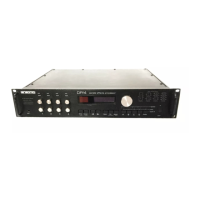Section 2 — Algorithms
ENSONIQ DP/4+ Reference Manual 53
03 — Decay Range: 0.70 to 250.0 sec.
Controls the amount of time it takes for the reverberation to decay away to a very low level after
the input signal stops. Higher values are recommended for the hall reverb.
04 — Predelay Time Range: 0 to 450 ms
Controls the amount of time it takes for the original signal to be presented to the reverb. Higher
values denote a longer delay.
05 — LF DecayTime Range: -99 to +99
Functions as a tone control and boosts (when set to a positive value) or cuts (when set to a
negative value) the rate at which low frequencies will decay.
06 — HF Damping Range: 00 to 99
Controls the rate of attenuation of high frequencies in the decay of the reverberation. As natural
reverb decays, some high frequencies tend to get absorbed by the environment. Increasing the
value of this parameter will gradually filter out (dampen) more and more high frequency energy.
07 — HF Bandwidth Range: 01 to 99
The high frequency bandwidth acts as a low pass filter on the signal going into the reverb,
controlling the amount of high frequencies that will pass into the effect. The higher the setting,
the more high frequencies are allowed to pass. This functions like a tone control on a guitar.
08 — Diffusion1 Range: 00 to 99
This parameter smears the input signal transients, to diffuse and smooth the sound. Lower
values will cause impulse sounds to appear as a series of discrete echoes, while higher values
tend to increase the smear (smoother sounding with fewer discrete echoes). We recommend
settings of 50 for starters.
09 — Diffusion2 Range: 00 to 99
This parameter, similar to and in series with Diffusion1, performs the same way but controls
lower frequency ranges. Experiment with different levels between the diffusion parameters to
find the settings that are right for your source.
10 — Decay Definition Range: 00 to 99
Controls the rate at which echo density is increased with time. Setting this parameter too high
can cause the echo density to build at a rate which exceeds the decay rate. A general rule of
thumb is this: Definition should not exceed the LF Decay Time added to the Decay Time.
11 — Detune Rate Range: 00 to 99
Controls the LFO rate of detuning introduced into the reverberation decay. Detuning creates a
slight oscillating pitch shift into the decay, giving it a more natural sound by breaking up
resonant modes.

